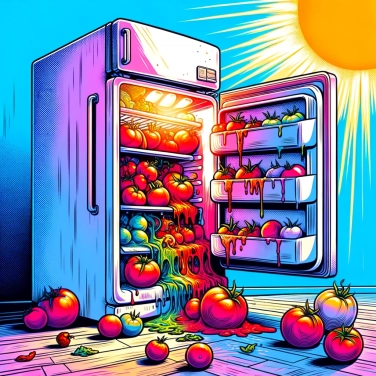The cold temperatures of the refrigerator alter the structure of the cell walls of tomatoes, leading to a loss of texture and the development of wilting.

Refrigeration leads to a slowing down and then a sudden halt of the tomato's natural chemical reactions. This cold stops the activity of volatile compounds, those small molecules responsible for aroma and flavor. As a result, the tomato appears bland, lacking in taste appeal. Instead of their usual fruity and rich flavor, they become barely better than balls of water. The longer the tomato stays in the cold, the more these changes become irreversible. Even when brought back to room temperature, the tomato will never fully regain its original aromas.
The tomato, by nature, is moderately sensitive to cold. When it is exposed to temperatures that are too low, the walls of its cells gradually deteriorate, leading to a loss of firmness and a somewhat soft or mealy texture. This phenomenon mainly occurs because cold damages the cells and disrupts their ability to retain water properly. As a result, water gradually escapes from the cells, and the tomato becomes slimy or mushy to the touch, seriously diminishing the desire to enjoy a nice fresh salad. This change in texture makes the tomato much less pleasant to eat, significantly less crunchy, and explains why it is better to avoid refrigerating tomatoes if you want to preserve their appealing qualities.
When a tomato is exposed to cold, its metabolism is disrupted. Instead of functioning normally, its cells change their operations. As a result, certain compounds like soluble sugars accumulate while other useful molecules, particularly volatile compounds responsible for taste and aromas, are lost. You end up with a tomato that tastes bland, is less aromatic, and whose natural internal balance is completely disturbed.
The cold significantly slows down the activity of certain enzymes present in tomatoes. These small molecules are essential for chemical reactions inside the fruit to occur efficiently. When a tomato is placed in the refrigerator, the cold hinders these reactions, directly impacting the production of compounds responsible for flavor and texture. As a result, tomatoes quickly become bland, mealy, soft—everything we prefer to avoid! The longer they stay in the cold, the more enzymatic activity decreases, preventing certain sugars and acids from being properly formed and leading to a progressive degradation of the fruit's cell membranes.
Tomatoes love a gentle atmosphere in terms of humidity. If the air becomes too dry, they quickly lose their water and start to wilt. Conversely, too much humidity in the fridge promotes mold and accelerates deterioration. The cold of the refrigerator often dries out the air, which removes some of the tomatoes' natural moisture, resulting in a wrinkled appearance and soft flesh. The secret is a precise balance: tomatoes simply prefer stable humidity, neither too humid nor too dry.
To slow down wilting without refrigeration, keep the tomatoes away from direct sunlight, in a cool, dry, and well-ventilated place.
Did you know that placing tomatoes near apples or bananas speeds up their ripening? This is due to the ethylene gas naturally produced by these fruits.
There is a simple method to enhance the flavor of a refrigerated tomato: take it out of the refrigerator a few hours before consumption to allow it to regain some of its taste qualities lost due to the cold.
Contrary to a common belief, the tomato is not a vegetable but, botanically speaking, a fruit — more specifically, a "berry"!
At room temperature (between 18 and 22°C), tomatoes can be stored in good conditions for 5 to 7 days. Beyond that, they are likely to start losing firmness and taste quality.
The cold from the refrigerator disrupts the volatile compounds responsible for the flavor of tomatoes. By refrigerating tomatoes, you slow down or partially stop their natural enzymatic activity, which significantly reduces their aroma and savory taste.
You can try to slightly revive wilted tomatoes by placing them at room temperature for a few hours. However, it is rare for the tomato to regain all of its original properties once cold damage has occurred.
Some varieties of tomatoes, particularly those with firm flesh like Roma or San Marzano tomatoes, are more resistant to wilting due to their compact flesh. However, no tomato will be able to withstand the prolonged negative effects of exposure to the cold of the refrigerator.
The optimal storage temperature for tomatoes is generally between 12°C and 20°C. At this temperature, they maintain their texture, flavors, and fresh appearance for an extended period.

No one has answered this quiz yet, be the first!' :-)
Question 1/5